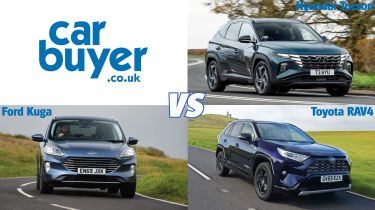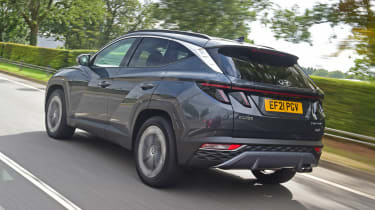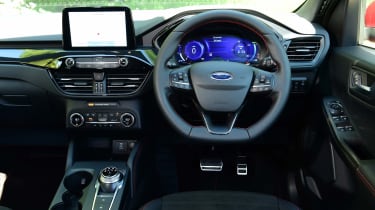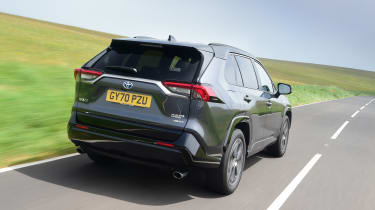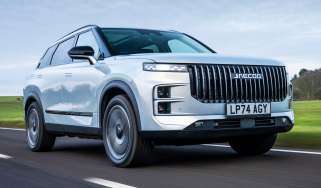Hyundai Tucson vs Ford Kuga vs Toyota RAV4: which should you buy?
All three of these family SUVs have multiple hybrid options and great interiors; we see which is best
Up until a couple of years ago, family SUVs tended to be bought with diesel engines. If you needed good pulling power or wanted reasonable fuel economy, diesel was the only choice. So it shows how times are changing that none of these big-selling SUVs are available with diesel power.
Instead, the Hyundai Tucson, Ford Kuga and Toyota RAV4 are leading the pack when it comes to electrification. All three are available as either a hybrid or plug-in hybrid (PHEV), and mild-hybrid engines are or have been offered on the Tucson and Kuga. There are other options, of course; the Honda CR-V is a hybrid, and there are PHEV versions of numerous family SUVs including the Vauxhall Grandland, Volkswagen Tiguan and Peugeot 3008. Or, you could go fully electric with the Volkswagen ID.4, Skoda Enyaq iV and Kia e-Niro.
But the cars we’re comparing here are among the best in the hybrid SUV class, and their choice of powertrains should mean they appeal to a wider cross-section of buyers. All look very modern and stylish, although the bold-styling of the Tucson will certainly stand out in any car park.
Which is the most economical?
On all three of these SUVs, the plug-in hybrid versions offer the lowest running costs on paper - albeit with higher list prices than standard hybrid versions. To get close to Hyundai’s claim of 201mpg and Ford and Toyota’s official 282mpg figures, you’ll need to do mainly stop-start journeys and charge the battery as often as possible. The plug-in hybrids may appeal to company-car users more than private buyers; all three slot into midrange Benefit-in-Kind tax bands, but are more expensive to buy than hybrid and petrol versions.
The hybrid versions return diesel-like fuel economy: you can expect up to 49.6mpg, 50.4mpg and 52.3mpg for the Tucson, RAV4 and Kuga respectively. These figures will provide low running costs for private buyers, and your fuel economy figure won’t fluctuate on long drives as much as it will with the plug-in hybrids.
Diesel versions of the Kuga and Tucson were initially available, but now 148bhp petrol engines are the only non-hybrid options in each model line-up. These can both return an MPG figure in the low 40s, so will be fine for private buyers with a low-to-medium annual mileage.
Which is the best to drive?
In terms of outright speed, the RAV4 Plug-In Hybrid will streak ahead of the Tucson and Kuga PHEVs. It’s the most powerful of the three, with 302bhp compared to the 261bhp of the Hyundai and the Ford’s 222bhp. As such, the RAV4 offers the fastest 0-62mph acceleration, at a mere six seconds. The Tucson takes 8.6 seconds and the Kuga takes around nine to complete the same benchmark.
Don’t think the RAV4 is a corner-crushing sports SUV, though. It’s refined to drive rather than involving, with a composed ride and decent steering. Despite being the slowest car here, the Kuga is the best to drive, with greater agility and steering feel than its rivals. The ride is a little firmer than the RAV4, and you may feel potholes slightly more. In the middle of the two, the Tucson is a little less nimble than the Kuga, but still good to drive, and keener than the RAV4. The Tucson hybrid is the quickest version in the range, taking a brisk eight seconds to reach 62mph.
Both the RAV4 and Kuga hybrids use a CVT gearbox. Toyota’s application is better than in the Ford, as the Kuga emits an unpleasant drone when you want to get up to speed quickly. The Ford is also the only front-wheel-drive plug-in hybrid here - the Hyundai and Toyota have all-wheel drive, and the hybrid RAV4 can also be specified with power going to all four wheels.
Which has the best interior?
The Ford Kuga’s interior will feel instantly familiar if you’re upgrading from a Focus or Fiesta, as most of the parts and technology are carried over. It isn’t the most eye-catching design, but everything’s where you expect it and the Kuga is very well-equipped. The RAV4 offers a decent array of equipment too, plus great build quality, but its infotainment system feels slightly outdated when compared with almost any other family SUV.
It’s clunky to operate and the graphics aren’t good enough, but at least you can use Apple CarPlay and Android Auto to use your phone’s apps instead - as you can on the Kuga and Tucson as well.
Hyundai’s interior design ticks all the boxes, though. It’s futuristic inside, and looks and feels like what you’d expect from a premium alternative like an Audi Q3. Hyundai’s cowl-less digital dial cluster is impressive, partly because it’s more configurable than the digital dials Ford fits in some Kuga models.
Which is the most practical?
Some of an SUV’s appeal lies in its practicality, and these cars are more spacious than the Hyundai i30, Ford Focus and Toyota Corolla. All three provide plenty of room for adults in the rear seats, and all offer enough boot space for an adventurous family holiday or a large dog.
The Tucson has the biggest boot, with between 558 and 620 litres depending on which engine you choose. The RAV4, with its 580-litre boot (520 for the PHEV) isn’t far behind, but the Kuga has the smallest loadspace here. You get between 412 and 526 litres, although versatility is improved by sliding rear seats.
Which is the cheapest?
A Kuga Zetec costs under £28,000 at the time of writing and offers a good amount of equipment, but we’d recommend upgrading to the more luxurious Titanium or the sporty ST-Line if you can afford it. These models should offer better residual values than the Zetec, too. The Tucson SE Connect is around £29,000, and the eye-catching Premium trim starts at under £31,000.
The RAV4 looks more expensive because it starts at around £32,000, but it’s only available as a hybrid. It costs less than the hybrid Tucson and Kuga models, partly because the Kuga FHEV is only available on higher trim levels.
Upgrading to the Kuga PHEV only costs around £1,800, which is good value considering the potential for super-low running costs. The plug-in Kuga starts at around £37,000, compared to over £39,000 for the equivalent Tucson. Toyota uses a much bigger battery and a more powerful motor in the RAV4 Plug-In Hybrid, which makes it far more expensive - it’s around £10,000 more than the cheapest RAV4 Hybrid.
Verdict - which should you buy?
All three of these handsome family SUVs have their merits. The Kuga is the best to drive and is good value, but not the last word in practicality. Toyota’s RAV4 feels durable and hushed - and has an incredible 10-year warranty - but the media screen disappoints and the plug-in hybrid is too costly for us to seriously recommend.
That leaves the Tucson, our reigning Carbuyer Car of the Year for 2022. It’s no secret that we love the Tucson’s high-tech, high-quality interior, and its styling is like no other car on sale. On top of that, it’s practical and good-to-drive, and overall we think it’s worth the price rise over the old, comparatively bland looking Tucson. We’d recommend the Tucson over nearly all its rivals, especially in mid-range Premium guise.
Check out our guides to the best hybrid SUVs and the best plug-in hybrids.
Recommended

New Subaru Trailseeker revealed as rugged electric SUV with 375bhp

New Subaru Solterra brings more range, power and polish
Most Popular

Suzuki’s new 10-year warranty is free – here’s how to get it
Tips & advice

Car dashboard warning lights: what does each symbol mean?

Electric car charging stations: public networks, charger types, apps and maps


